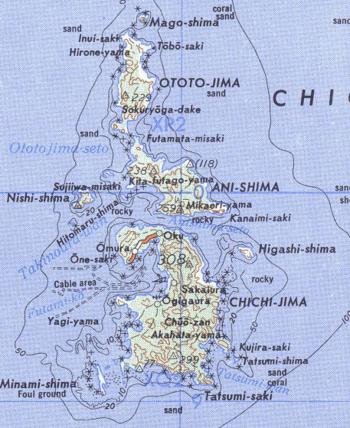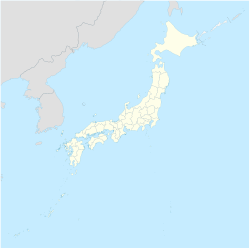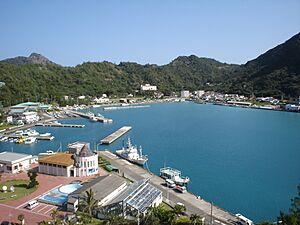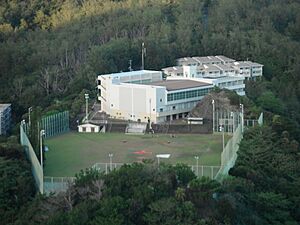Chichijima facts for kids
|
Native name:
Japanese: 父島
|
|
|---|---|

Map of Chichijima, Anijima and Otoutojima
|
|
| Geography | |
| Location | Pacific Ocean |
| Coordinates | 27°4′0″N 142°12′30″E / 27.06667°N 142.20833°E |
| Archipelago | Ogasawara Islands |
| Area | 23.45 km2 (9.05 sq mi) |
| Highest elevation | 326 m (1,070 ft) |
| Administration | |
|
Japan
|
|
| Prefecture | Tokyo |
| Subprefecture | Ogasawara Subprefecture |
| Village | Ogasawara |
| Demographics | |
| Population | 2,120 (2021) |
| Pop. density | 90.4 /km2 (234.1 /sq mi) |
| Ethnic groups | Japanese, mixed |
Chichijima (父島) is the largest and most populated island in the Bonin or Ogasawara Islands. It is located about 240 km (150 mi) north of Iwo Jima. The island is 23.5 km2 (9.1 sq mi) in size and is home to about 2,120 people (as of 2021).
Even though it is far from the mainland, Chichijima is part of Tokyo. It is the main administrative center for Ogasawara Village and Ogasawara Subprefecture. Chichijima, along with the Volcano and Izu Islands, forms part of Japan's Nanpō Islands.
Long ago, Chichijima was not inhabited. It was later settled by an international group from Kingdom of Hawaii in 1830. This group became the start of the Ōbeikei ethnic group. Later, Britain agreed to Japan's claim over the island. Japan then officially took control and established two villages.
During Second World War, the people living on the island were moved to Honshu for safety. After the war, the United States Armed Forces occupied the islands for about 20 years. Only the Ōbeikei people were allowed to return at first. When Japan regained control in 1968, more Japanese from the mainland moved back.
Contents
What Does Chichijima Mean?
The names of the Bonin Islands in Japanese are often based on family relationships. This naming system was set up after an expedition in 1675. Chichijima (父島) means "Father Island."
The island has had other names in the past. These include Graft Island, named after a Dutch ship. It was also called Peel Island, after a British leader named Robert Peel. Sometimes it was simply known as the Main Island.
A Look at Chichijima's History
Early Discoveries
Some old tools from Micronesia have been found on other Bonin Islands, but Chichijima itself was empty for a long time. Stories about the island being discovered by a Japanese samurai clan are not true. Also, claims that the Spanish explorer Bernardo de la Torre found Chichijima in 1543 are incorrect.
The first definite sighting of Chichijima by Europeans was in 1639. This happened during a Dutch expedition looking for mythical "Islands of Gold and Silver."
A Japanese merchant ship was blown off course in 1669 and landed on Hahajima, another island nearby. The crew later visited Chichijima and reported their findings to the Japanese government. This led to a secret mission in 1674-1675 to explore and map the islands. After this, Japan decided to keep the islands isolated, and they remained uninhabited until 1830.
First Settlers and New Claims
In the early 1800s, Western explorers visited Chichijima. They noted that the island had natural springs, making it a good stop for whalers.
The first permanent settlement began in May 1830. A group from Hawaii, led by an Italian-born British subject named Matteo Mazzaro, arrived. This group included Hawaiians, Britons, Americans, and a Dane. Later, an American sailor named Nathaniel Savory became the leader of the settlers. More Americans, Europeans, and Pacific Islanders joined them over time.
In 1853, Commodore Matthew C. Perry from the United States visited Chichijima. He claimed the island for the U.S. to use as a coaling station for steamships. Perry appointed Nathaniel Savory as an official agent for the U.S. Navy.
Japanese Control Begins
In 1862, Japan officially declared its ownership of the Ogasawara Islands, including Chichijima. The people already living there were allowed to stay, and Savory's leadership was recognized.
Over time, more ethnic Japanese people moved to the island. They eventually outnumbered the descendants of the first settlers, who were called Oubeikei (meaning "Westerners"). A unique language called Bonin English developed on Chichijima, mixing Japanese, English, and Hawaiian words.
After the Meiji restoration in Japan, more Japanese colonists arrived in 1876. The island officially became part of Tokyo Metropolis in 1880. A small naval base was built on Chichijima in 1914.
Chichijima During World War II
Chichijima was very important during World War II. It had long-range Japanese radio stations and was a key supply and communication base for the Nanpō Shotō. It also had a large number of soldiers stationed there.
During the war, the Oubeikei residents were sometimes seen with suspicion by Japanese authorities. In 1944, all 6,886 civilians were ordered to leave the Ogasawara islands and go to mainland Japan.
The island was often attacked by the U.S. Navy from the air. Future U.S. President George H. W. Bush was shot down near Chichijima during one of these raids, but he was rescued.
Japanese troops from Chichijima were sent to help defend Iwo Jima before the famous Battle of Iwo Jima in 1945. Chichijima itself was never captured by Allied forces. At the end of the war, about 25,000 Japanese troops in the island chain surrendered. Some soldiers faced serious charges related to their actions during the war.
Under U.S. Occupation
After World War II, the United States occupied Chichijima for two decades. They kept the former Japanese naval base and seaplane base.
Initially, most of the island's civilian population was not allowed to return. Only 129 Oubeikei people were permitted to come back. During the U.S. occupation, there were reports that some islands, including Chichijima, were used to store certain military equipment.
In 1960, a tsunami caused by the Great Chilean earthquake damaged the harbor facilities.
Chichijima Today
Chichijima was returned to Japanese civilian control in 1968. At that time, the Oubeikei residents could choose to be U.S. or Japanese citizens. Many who chose U.S. citizenship still visit the island often.
By the early 2000s, nearly 200 residents identified as "Americans" or Oubeikei. However, most residents today are Japanese who moved to the island after 1970.
Island Geography and Weather
Chichijima is located at 27°4′0″N 142°12′30″E / 27.06667°N 142.20833°E. The island covers about 24 km2 (9.3 sq mi).
The island chain was known as the Bonin Islands on old English maps. The name "Bonin" comes from an old Japanese word, 'munin', which means 'no man' or "no man's land."
Chichijima has a warm and humid climate all year round. Temperatures usually stay between 9.2–34.1 °C (48.6–93.4 °F). The island gets less rain than mainland Japan because of its location. However, sometimes very heavy rain can fall, especially during storms.
| Climate data for Chichijima (1991−2020 normals, extremes 1968−present) | |||||||||||||
|---|---|---|---|---|---|---|---|---|---|---|---|---|---|
| Month | Jan | Feb | Mar | Apr | May | Jun | Jul | Aug | Sep | Oct | Nov | Dec | Year |
| Record high °C (°F) | 26.1 (79.0) |
25.4 (77.7) |
26.7 (80.1) |
28.4 (83.1) |
30.1 (86.2) |
33.0 (91.4) |
34.1 (93.4) |
33.7 (92.7) |
33.1 (91.6) |
32.1 (89.8) |
30.2 (86.4) |
27.5 (81.5) |
34.1 (93.4) |
| Mean daily maximum °C (°F) | 20.7 (69.3) |
20.5 (68.9) |
21.7 (71.1) |
23.4 (74.1) |
25.6 (78.1) |
28.5 (83.3) |
30.4 (86.7) |
30.3 (86.5) |
29.9 (85.8) |
28.6 (83.5) |
25.9 (78.6) |
22.7 (72.9) |
25.7 (78.3) |
| Daily mean °C (°F) | 18.5 (65.3) |
18.1 (64.6) |
19.3 (66.7) |
21.1 (70.0) |
23.4 (74.1) |
26.2 (79.2) |
27.7 (81.9) |
28.0 (82.4) |
27.7 (81.9) |
26.4 (79.5) |
23.8 (74.8) |
20.6 (69.1) |
23.4 (74.1) |
| Mean daily minimum °C (°F) | 15.8 (60.4) |
15.4 (59.7) |
16.8 (62.2) |
18.8 (65.8) |
21.4 (70.5) |
24.4 (75.9) |
25.6 (78.1) |
26.1 (79.0) |
25.7 (78.3) |
24.4 (75.9) |
21.6 (70.9) |
18.2 (64.8) |
21.2 (70.2) |
| Record low °C (°F) | 8.9 (48.0) |
7.8 (46.0) |
9.2 (48.6) |
10.7 (51.3) |
13.9 (57.0) |
17.7 (63.9) |
20.8 (69.4) |
22.2 (72.0) |
19.6 (67.3) |
17.2 (63.0) |
13.2 (55.8) |
10.8 (51.4) |
7.8 (46.0) |
| Average precipitation mm (inches) | 63.6 (2.50) |
51.6 (2.03) |
75.8 (2.98) |
113.3 (4.46) |
151.9 (5.98) |
111.8 (4.40) |
79.5 (3.13) |
123.3 (4.85) |
144.2 (5.68) |
141.7 (5.58) |
136.1 (5.36) |
103.3 (4.07) |
1,296.1 (51.03) |
| Average snowfall cm (inches) | 0 (0) |
0 (0) |
0 (0) |
0 (0) |
0 (0) |
0 (0) |
0 (0) |
0 (0) |
0 (0) |
0 (0) |
0 (0) |
0 (0) |
0 (0) |
| Average precipitation days (≥ 0.5 mm) | 11.0 | 8.5 | 9.8 | 10.0 | 11.8 | 8.8 | 8.6 | 11.3 | 13.4 | 13.7 | 12.0 | 11.2 | 130.2 |
| Average relative humidity (%) | 66 | 68 | 72 | 79 | 84 | 86 | 82 | 82 | 82 | 81 | 76 | 70 | 78 |
| Mean monthly sunshine hours | 131.3 | 138.3 | 159.2 | 148.3 | 151.8 | 205.6 | 246.8 | 213.7 | 197.7 | 173.2 | 139.1 | 125.3 | 2,030.6 |
| Source: Japan Meteorological Agency | |||||||||||||
Island Development and Facilities
Astronomy and Space Tracking
Chichijima is home to important scientific facilities. The National Astronomical Observatory of Japan (NAOJ) has a radio astronomy station there. This station is part of a larger network of telescopes used to study deep space.
The Japan Aerospace Exploration Agency (JAXA) also has a facility on Chichijima. This station helps track rockets launched from the Tanegashima Space Center. It uses radar to check the rockets' flight paths and safety.
Since 1968, the Japan Maritime Self-Defense Force (JMSDF) has operated the Chichijima Naval Base. This includes a heliport and facilities for seaplanes.
Wildlife on Chichijima
Birds of the Island
Sadly, some bird species that once lived on Chichijima are now extinct. This might be because new animals were brought to the island. These include the Bonin nankeen night heron, the Bonin grosbeak, and the Bonin thrush. The Bonin wood-pigeon also disappeared in the late 1800s.
Today, Chichijima and its nearby islands are recognized as an Important Bird Area (IBA). This is because they support populations of Japanese wood pigeons and Bonin white-eyes.
Green Sea Turtles
The people of Chichijima have traditionally caught and eaten green turtles for food. In the early 1900s, too many turtles were caught, and their numbers dropped.
Now, strict rules are in place to protect the turtles. Only one fisherman is allowed to catch them, and the number is limited to 135 per season. The Fisheries Agency and the Tokyo Metropolitan Government run a special facility to help conserve green turtles. They collect eggs, raise baby turtles, and then release them into the wild with identification tags. Thanks to these efforts, the number of green turtles is slowly increasing.
Education on Chichijima
Ogasawara Village manages the public elementary and junior high schools on the island:
- Ogasawara Municipal Ogasawara Junior High School (小笠原村立小笠原中学校)
- Ogasawara Elementary School (小笠原小学校)
The Tokyo Metropolitan Government Board of Education operates Ogasawara High School on Chichijima.





